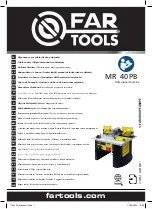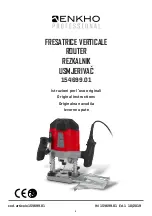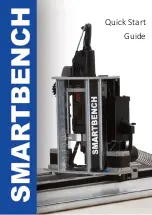
35
English
• Maintain firm grip with both hands on router to resist
starting torque.
• Keep hands away from cutting area. Never reach under
the workpiece for any reason.
Keep the router base firmly in
contact with the workpiece when cutting. These precautions will
reduce the risk of personal injury.
• Never run the motor unit when it is not inserted in one of
the router bases.
The motor is not designed to be handheld.
• Keep cutting pressure constant.
Do not overload motor.
• Check to see that the cord will not snag or impede the
routing operation.
• Use sharp cutters.
Dull cutters may cause the router to swerve
or stall under pressure.
• Be sure that the motor has stopped completely before you
lay the router down.
If the cutter head is still spinning when the
tool is laid down, it could cause injury or damage.
• Be sure that the router bit is clear of the workpiece before
starting the motor.
If the bit is in contact with the workpiece
when the motor starts it could make the router jump, causing
damage or injury.
• ALWAYS disconnect tool from power source before making
adjustments or changing bits.
• Keep hands clear of bit when motor is running to prevent
personal injury.
• NEVER touch the bit immediately after use.
It may be
extremely hot.
• Provide clearance under workpiece for router bit when
through-cutting.
• Tighten collet nut securely to prevent the bit from slipping.
• Never tighten collet nut without a bit.
• Do not use router bits with a diameter in excess of 1-3/8”
(34.9 mm) in this tool.
• Always use cutters with a shank diameter of 1/4” (6.4 mm) which
corresponds to the size of the collet in your tool.
• Always use cutters suitable for a speed of min. 27,000 min
-1
and
marked accordingly.
• Not recommended for use in a router table.
• Avoid climb-cutting (cutting in direction opposite that shown
in Figure 12). Climb-cutting increases the chance for loss of
control resulting in possible injury.
•
When climb-cutting is required (backing around a corner), exercise
extreme caution to maintain control of router. Make smaller cuts
and remove minimal material with each pass.
•
An extension cord must have adequate wire size for safety.
An undersized cord will cause a drop in line voltage resulting in loss
of power and overheating. When using more than one extension
to make up the total length, be sure each individual extension
contains at least the minimum wire size. The following table shows
the correct size to use depending on cord length and nameplate
ampere rating. If in doubt, use the next heavier gauge. The smaller
the gauge number, the heavier the cord.
Voltage (Volts)
Total length of cord in meters (m)
120–127V
0–7
7–15
15–30
30–50
220–240V
0–15
15–30
30–60
60–100
Rated Ampere
range
Minimal cross-sectional area of the
cord in meters (mm
2
)
0–6A
1.0
1.5
1.5
2.5
6–10A
1.0
1.5
2.5
4.0
10–12A
1.5
1.5
2.5
4.0
12–16A
2.5
4.0
Not Recommended
















































